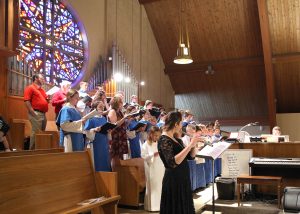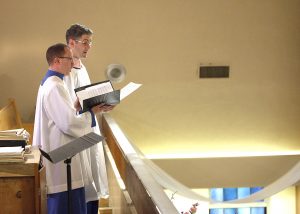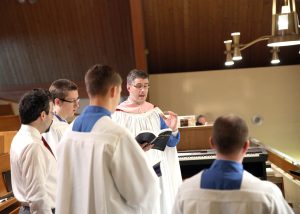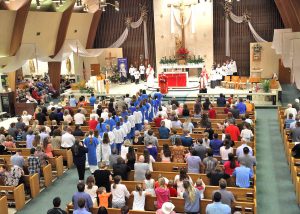It has been some time since last I wrote about chorister training, and now that the school year is fully underway, I thought it might be helpful to offer a refresher on the logistics of training our young people in the art of liturgical music.
I think the largest hurdle most choir directors face is actually working with children (if that is not one’s cup of tea). As always, there are both joys and drawback working with children as opposed to teenagers or even adults. Children bring an enthusiasm to choir rehearsal that is rarely topped and they have no preconceived bias toward learning to sight-sing. While your adult sopranos will begin to squirm as soon as you warm them up above a G or A below high C, that won’t be the case with children. On the other hand, if you have a great group of adults, they will move through music at an incredible rate of speed, which is the cause of deep satisfaction in the director AND the singers. Adults generally spare you discipline problems that spill out of children and there is the joy of adult interaction. Regardless, there are three areas that are especially helpful to be competent in when working with children.
First is the creation of routine. Routine helps children to grow. A proper routine can also steer children away from discipline problems. Every choir needs to have a healthy routine so the children know from the moment they walk through the door what is expected of them. I would highly recommend the book The First Days of School by Wong and Wong. It deals primarily with the classroom setting, but the routine of a choir is no different. If you set a certain tone in the first few rehearsals, you and your choristers will be off to a great start.
Second is the teaching of children. Knowing how different boys and girls are and how these differences help them learn differently is crucially important. Also important is knowing the difference between the way children and adults learn. Even within children, there are different learning styles depending upon the age and maturity of a child. If you are running a choral program from children in kindergarten through high school, I would suggest you acquaint yourself with the 3 main learning styles in the classical model: the grammar, logic and rhetorical stages. This is especially helpful when teaching younger children. As for working with junior high and high school children I would suggest reading Teach Like a Champion by Doug Lemov. All too often choir directors rely on a couple of key singers to support the entire choir as opposed to building everyone up into an effective choral unit. How do you help underachievers to work at the level of your best choristers? How do you help every child understand that he/she is absolutely crucial to the choir and that they need to work as if they, too, know that? Teach Like a Champion gives so many helps toward this goal that I can’t recommend it highly enough. I would warn you though, you must practice many of these concepts in front of a mirror before you use them in the class room.
Third, you will have to have a basic understanding of psychology. The same group of singers will one day make you think you have the best choir in the world and the next day make you wonder if they have ever sung two notes together. They will have a terrible pre-concert rehearsal and then dazzle you in the concert itself. On the flip side, they will also rehearse so well before Mass that you can’t understand why they sound awful 15 minutes later when Mass begins. Do you ride out the terrible music or is there a way to turn around a bad situation in the middle of it? Sports psychology is especially helpful here and there are so many of these books that you could probably choose one whose author and specific subject matter appeals to you personally and be fine.
Once you find yourself settling down to the actual teaching, the obvious question is how? For the traditional English way adapted to the Catholic setting (especially for the ancient form of the Mass) your first read should be Sir Richard Terry’s Catholic Church Music. His early time at Westminster Cathedral coincided with a flowering of liturgical and musical life within both the Catholic and Anglican spheres and many major English choir directors were writing books to explain to smaller parish choirs how the cathedrals did it. You can find many of these free and online at Google Books, but again, just start with Terry. You will find that while the cathedral music scene in England (Catholic or Anglican) has changed through the decades in regard to music choice, you will nevertheless find that the method is still rather the same. At the same time, I would say that the method has been broadened and deep by the addition of singing coaches and mandatory piano lessons (if not other lessons) for choristers. Every student you are able to coax into piano lessons will be nothing but a step forward for your choir. I can almost always tell the difference between choristers with similar abilities when one plays the piano and the other doesn’t.
If you find joy in creating a music curriculum for your students (and you should always try to deepen their musical knowledge), then all you need to do is decide what skills and to what level children need to learn them and then create a plan to systematically teach them. If this is not your forte, you might want to look at some of the current choral music training programs. Perhaps the Ward Method, Kodaly Method or Voices for Life (from the Royal School of Church Music) are right for you. I also highly recommend anything written by John Bertalot. I will caution that it takes an enormous amount of time to teach sight-singing, so many choral directors skip it. Please don’t. You are cheating your students and depriving them of a skill set that will provide one of life’s great experiences, being able to both create and perform music to a high level.
You will of course need repertoire for your choirs, and repertoire that is appropriate to where your choristers are musically. I have said it before and will say it many times again, I would rather hear children sing a hymn in unison or a piece of plainchant to a high degree that to hear them butcher even the simplest of 4 part motets. If you struggle finding repertoire don’t hesitate to ask online at places like the CMAA Forum. Look through the Corpus Christi Watershed website or Cantica Nova. Visit music lists of cathedrals or churches with a children’s choir at the same level as yours. I would even suggest simply teaching your choristers the liturgical music currently in use at your parish, but to a high degree. They will already have heard much of it, but your parishioners will notice it being sung well by a choir as opposed to being belted at various levels of competency through a microphone by one of your cantors. Do not be afraid to start with SIMPLE, as long as the text and music are of a high quality.
Lastly, try to get as much parental involvement as you can. You will need it to handle large groups of children and you will also widen your sphere of influence in the parish. If even a few influential parents in your parish think that you provide a program of high quality for their children, they will tell others and make your life (and recruiting) much easier. In the end, you will create life long friendship that will bring great joy to your good days and comfort to those difficult ones.



